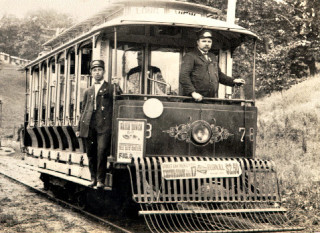Read an excerpt from this article below. You can download the full article by using the link at the end of the excerpt.
Noted planning historian Laurence C. Gerckens offers a fascinating look at 10 key developments that shaped the 20th century American city. The article also includes numerous photos, plus sidebars on: tenement housing; the Model-T; the Triangle Fire; Dams; Levittown; and interstate highways.
1. 1847: The beginning of massive immigrations
2. 1885: Introduction of the steel-framed “skyscraper”
3. 1886: Invention of the electric trolley car [see excerpt below]
The first successful electric trolley car was put in operation in Montgomery, Alabama by J. Van Depoele in 1886. It did for the upper-middle-incomed what the earlier steam locomotive did for the wealthy: it gave them access to the perimeter of the city, permitting them to isolate themselves from the urban poor and the filth and ugliness of the urban industrial environment.

The electric trolley car permitted creation of higher income-class corridors extending outward from the city center, removing from the city center all but the lower-middle- and the lower-incomed.
With removal of those with higher spendable wealth to the transit corridors, the trolley system created alternative sites for retail trade and services at trolley stops beyond the city center, including trolley-focused perimeter shopping centers such as Shaker Square, Cleveland.
Finer homes and apartments lined trolley routes, which provided prestigious locations that were both convenient to transportation and highly visible.
The land in the quadrants between the branches of the trolley system that radiated outward from the center of the city, beyond a four-to-eight block walking distance from the trolley lines, commonly remained undeveloped for residential use and was often used for foundries, slaughter houses, garbage dumps, and, in the 1920s, the first close-in airports. Many of the residential trolley corridors of the early 1900s became strip commercial corridors when the private automobile replaced the station-stop focused trolley car. [end of excerpt]
4. 1893: The Columbian Exposition
5. 1908: Introduction of the inexpensive automobile
6. 1916: Adoption of the New York City Zoning Code
7. 1929: The stock market crash
8. 1940-45: The Second World War
9. 1950+: The Cold War
10. 1958: Introduction of commercial jet aircraft …